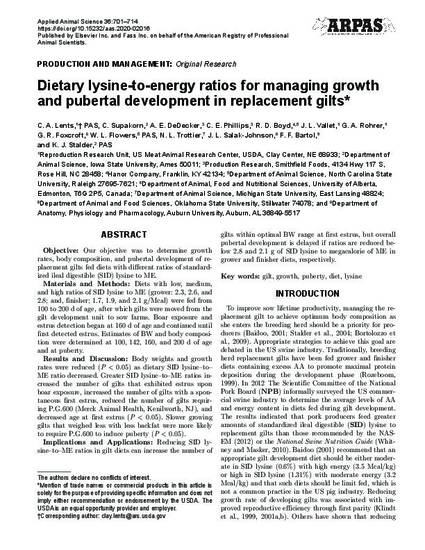
Objective: Our objective was to determine growth rates, body composition, and pubertal development of replacement gilts fed diets with different ratios of standardized ileal digestible (SID) lysine to ME.
Materials and Methods: Diets with low, medium, and high ratios of SID lysine to ME (grower: 2.3, 2.6, and 2.8; and, finisher; 1.7, 1.9, and 2.1 g/Mcal) were fed from 100 to 200 d of age, after which gilts were moved from the gilt development unit to sow farms. Boar exposure and estrus detection began at 160 d of age and continued until first detected estrus. Estimates of BW and body composition were determined at 100, 142, 160, and 200 d of age and at puberty.
Results and Discussion: Body weights and growth rates were reduced (P < 0.05) as dietary SID lysine–to– ME ratio decreased. Greater SID lysine–to–ME ratios increased the number of gilts that exhibited estrus upon boar exposure, increased the number of gilts with a spontaneous first estrus, reduced the number of gilts requiring P.G.600 (Merck Animal Health, Kenilworth, NJ), and decreased age at first estrus (P < 0.05). Slower growing gilts that weighed less with less backfat were more likely to require P.G.600 to induce puberty (P < 0.05).
Implications and Applications: Reducing SID lysine– to–ME ratios in gilt diets can increase the number of gilts within optimal BW range at first estrus, but overall pubertal development is delayed if ratios are reduced below 2.8 and 2.1 g of SID lysine to megacalorie of ME in grower and finisher diets, respectively.
Available at: http://works.bepress.com/kenneth_stalder/246/

This article is published as Lents, C. A., C. Supakorn, A. E. DeDecker, C. E. Phillips, R. D. Boyd, J. L. Vallet, G. A. Rohrer et al. "Dietary lysine-to-energy ratios for managing growth and pubertal development in replacement gilts." Applied Animal Science 36, no. 5 (2020): 701-714. doi: 10.15232/aas.2020-02016.